Prune roses for maximum bloom
-
Consider removing four types of branches at the outset – those that are dead, diseased, damaged, or dysfunctional. Examples of dysfunctional branches include those that are competing, crossing, or crowded.
Seems that for many people, pruning roses is right up there with visiting the dentist. You know you need to do it, but boy, do you dread it.
There's no need to be intimidated — you're simply cutting back a plant. Roses are very forgiving. If you cut too high, too low, or at an inward-facing bud rather than an outward-facing one, in the long run it really won't make a lot of difference.
While it's likely the least interesting and most labor-intensive aspect of caring for our national flower, pruning is an important one. Besides getting rid of the nasty three Ds — the dead, damaged, and diseased portions of the plant — pruning allows you to get a rose back to a shape and size that is desirable for your garden and stimulates growth to produce oodles of blooms in the spring. Here are some general rose-pruning tips to help you get started:
Time it right: Most types of roses get pruned when they are dormant, generally late December through mid-February.
Dress for the occasion: Wear hard-finish clothing (like denim) that is more resistant to punctures from thorns and cover your arms with long sleeves. Wear strong, durable, flexible gloves — the type with gauntlets covering the forearm provides extra protection. Wear glasses or goggles to protect your eyes.
Use the right tools: Have your cutting tools oiled, adjusted, and very sharp. Bypass-type shears and loppers are best, as they make a clean cut without crushing or bruising canes. A small pruning saw, preferably with fine teeth, is highly desirable for cutting large canes and getting into places that can't be reached with shears or loppers.
Consider the type: Floribunda, shrub, and English-type roses as well as miniatures often have a lot of interior twiggy growth that should be removed. Climbing roses are trained with major canes in a horizontal position — focus on the upright canes coming from each main cane and cut them fairly short, leaving three to five buds on each. Old garden, once-blooming roses produce next season's flowers right after they bloom, so don't prune them in the winter or you'll be pruning your spring flowers away.
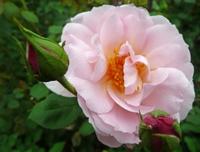 Belle Story English shrub rose
Belle Story English shrub rose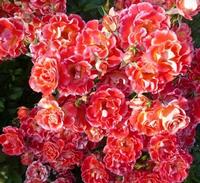 Stretch Johnson floribunda
Stretch Johnson floribunda Westerland climber
Westerland climber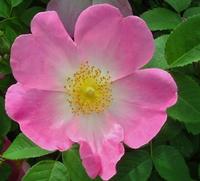 Complicata once blooming
Complicata once blooming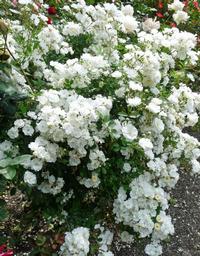 Gourmet Popcorn mini rose
Gourmet Popcorn mini roseThink about your safety: Pay attention to where you're placing your hands. Roses don't stick you; you stick yourself on the roses. This will help protect you from a potentially serious fungal infection known as sporotrichosis or rose-thorn disease. Confirm before you start that you've had a tetanus shot in the past 10 years.
Look for the buds: A bud eye is the slightly swollen reddish spot where a leaf cluster is or was connected on a cane. Choose ones that face away from the plant to keep canes from growing together in the middle of the bush.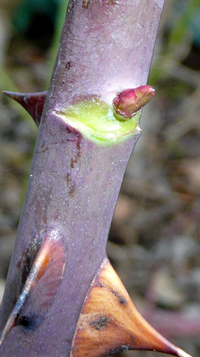 Choose bud eyes that face outward.
Choose bud eyes that face outward.
Making the cuts: Start with the largest portions of the plant you want to take out — it makes the job go more quickly. Remove between one to two-thirds of the plant starting with any that are dead, diseased, damaged, or dysfunctional. Examples of dysfunctional canes include those that are weak, twiggy, crossing, or create dense interior growth. Also completely remove any suckers — that's the verdant growth that emanates from below the bud union on grafted plants. Cut back to good healthy wood — look for white or cream-colored pith (interior of cane). Make the cut about ¼” above the bud, at an angle so that water drains away from the bud. Take out any canes thinner than a pencil; a stem growing from another will never be larger than its source, so that leaving a skinny stem will produce an even wimpier one that won't be able to hold up a bloom. Cut out older, nonproductive canes right down to the bud union.Clean up when you're done: Once all your cutting is complete, remove any remaining leaves from the plant and dispose of them, along with stems and canes from the area (don't compost them because they can carry pests and disease).
Remember that roses are very forgiving. If you make cuts that are less than ideal, it won't hurt the rose. Just like a bad haircut, it may look odd for a while, but it will grow back.
Photos and original article by Nanette Londeree for the Marin IJ
Edited by Marie Narlock for the Leaflet






